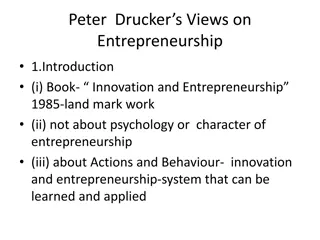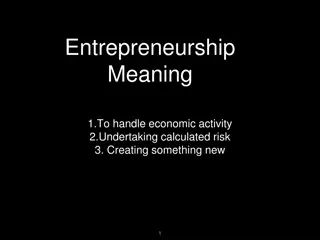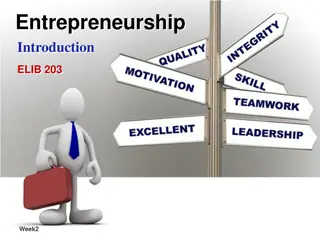Understanding Entrepreneurship: Key Elements and Characteristics
An entrepreneur combines factors of production, converts raw material into finished products, and sells them for profit. Entrepreneurship involves innovation, risk-taking, vision, and organizing skills. To succeed, entrepreneurs need to be risk-takers, perceptive, and curious about challenges. Different types of participants exist in the entrepreneurial world, such as achievers, dreamers, undeciders, and those who abandon their ideas. Developing entrepreneurial characteristics requires education, hard work, and planning.
Download Presentation

Please find below an Image/Link to download the presentation.
The content on the website is provided AS IS for your information and personal use only. It may not be sold, licensed, or shared on other websites without obtaining consent from the author. Download presentation by click this link. If you encounter any issues during the download, it is possible that the publisher has removed the file from their server.
E N D
Presentation Transcript
Sanjay Bartwal Chief Consultant NIESBUD
The term 'Entrepreneur' -French word 'Entreprendre (meaning to undertake certain activities) 1) Produces a product 2) Sells & market the product 3) Bear overheads like :- *Pays rent of Land and building *wages to labor *interest on capital *later generate profit
Working Definition An entrepreneur is a person who combines various factors of production, processes raw material, converts the raw material into a finished product and creates utility and sells the produce in the market to earn profit. ENTREPRENEURS ARE MADE AND NOT BORN.
ENTERPRISE : Entrepreneurial activity, especially when accompanied by initiative and resourcefulness.
ENTREPRENEURSHIP may defined in various ways, but the four key elements involved in it are: i. Innovation. ii.Risk-taking. iii.Vision. iv.Organizing skill. The capacity and willingness to develop, organize and manage a business venture along with any of its risks in order to make a profit. The most obvious example of entrepreneurship is the starting of new businesses.
Types of Participants DOERS : Achievers DREAMERS : Doing something but not their dream project DWADLERS : Undecided DUDS : Abandoned their ideas of being entrepreneur
Entrepreneurial Characteristics Being an entrepreneur requires specific characteristics and skills that are often achieved through education, hard work, and planning. Risk Taker Businesses face risk. Entrepreneurs minimize risk through research, planning, and skill development. Perceptive Entrepreneurs challenges. view problems as opportunities and Curious Entrepreneurs like to know how things work. They take the time and initiative to pursue the unknown.
Entrepreneurial Characteristics Imaginative Entrepreneurs are creative. They imagine solutions to problems that encourage them to create new products and generate ideas. Persistent True entrepreneurs face bureaucracy, make mistakes, receive criticism, and deal with money, family, or stress problems. But they still stick to their dreams of seeing the venture succeed. Goal-setting Entrepreneurs are motivated by the excitement of staring a new business. Once achieved, they seek out new goals or ventures to try.
Entrepreneurial Characteristics Self-confident Entrepreneurs believe in themselves. Their self-confidence takes care of any doubts they may have. Flexible Entrepreneurs must be flexible in order to adapt to changing trends, markets, technologies, rules, and economic environments. Independent An entrepreneur s desire for control and the ability to make decisions often makes it difficult for them to work in a controlled environment. Hardworking Entrepreneurs need a great deal of energy to see a venture start and succeed. Yet they are not deterred by the long hours to achieve their goal.
Stages of Entrepreneurship Stage One The Dreamer. This is where the idea for a business is born. The dream is the culmination of the entrepreneur s life experiences and passions. Stage Two The Architect. This stage is where the dream is interpreted into a business model which becomes the blueprint of the venture. The Dreamer typically does not make a good Architect.
Stage Three The Builder. This is the stage where the dream can first become reality. The Builder then literally turns the dream into reality. We are now at a critical juncture of the venture. Stage Four The Cultivator. This is the growth stage. Once the business is launched the Cultivator s primary role is to guide the business through the various levels of growth.
Classification of Entrepreneur Innovative entrepreneur : - Such entrepreneurs introduce new goods or new methods of production or discover new markets or reorganize the enterprise. Examples of first movers include innovative companies such as eBay and Coca- Cola. eBay was the first company to take the auction process online, kicking off operations in 1995. Imitative or adoptive entrepreneur :- Such entrepreneurs don t innovate, they copy technology or technique of others.. Such entrepreneurs are significant for under-developed economies because they put such economies on high rate of economic development`EX: Chinese mobiles.
Prime mover :- This entrepreneur sets in motion a powerful sequence of development expansion and diversification of business. EX: Ambani Manager :- Such an entrepreneur doesn t initiate expansion and its content in just staying in business. The artists:- Are highly creative type, very conscious about business. EX: Aamir Khan, Michael Dell (Dell), Deep Kalra (Make my trip) The visionary:- Too focused on dreams with little focused on reality. EX: Jack Welch(GE), Bill Gates (Microsoft), Kishore Biyani(Future Group), Warren Buffet (Berkshire Hathaway), Sam Walton(Wall Mart).
Problems of Entrepreneurship Development Programmes (EDPs) are: 1. No Policy at the National Level. Though Government of India is fully aware about the importance of entrepreneurial development, yet we do not have a national policy on entrepreneurship. It is expected that the government will formulate and enforce a policy aimed at promoting balanced regional development of various areas through promotion of entrepreneurship. 2. Problems at the Pre training Phase. Various problems faced in this phase are identification of business opportunities, finding & locating target group, selection of trainee & trainers etc.
3. Over Estimation of Trainees. Under EDPs it is assumed that the trainees have aptitude for self employment and training will motivate and enable the trainees in the successful setting up and managing of their enterprises. These agencies thus overestimate the aptitude and capabilities of the educated youth. Thus on one hand the EDPs do not impart sufficient training and on the other financial institutions are not prepared to finance these risky enterprises set up by the not so competent entrepreneurs. 4. Duration of EDPs. An attempt is made during the conduct of EDPs to prepare prospective entrepreneurs thoroughly for the various problems they will be encountering during the setting up and running of their enterprises. Duration of most of these EDPs varies between 4 to 6 weeks, which is too short a period to instill basic managerial skills in the entrepreneurs. Thus the very objective to develop and strengthen entrepreneurial qualities and motivation is defeated.
5. Non Availability of Infrastructural Facilities. No prior planning is done for the conduct of EDPs. EDPs conducted in rural and backward areas lack infrastructural facilities like proper class room suitable guest speakers, boarding and lodging etc. 6. Improper Methodology. The course contents are not standardized and most of the agencies engaged in EDPs are themselves not fully clear about what they are supposed to do for the attainment of pre-determined goals. This puts a question mark on the utility of these programmes.
Need of Entrepreneurship Increases national production Balanced area development Dispersal of economic power Reinvestment of profit for the welfare of the area of profit generation Development is a function of motivation and human resource Entrepreneurial awareness
Steps to Promote Entrepreneurship Setup Entrepreneurial Development Institutes in every state. Recognize and celebrate entrepreneurship among youth as a preferred career. Enhance access to finance for start-ups in every possible way. Reduce the time of starting a business and ease down the complex procedures of Govt licensing and other such activities like finance and banking etc. Promote entrepreneurship among women and other underprivileged.
Every Big Enterprises Starts with a small Dream So Keep Dreaming




























